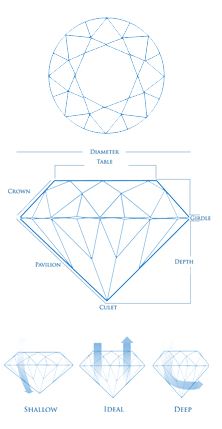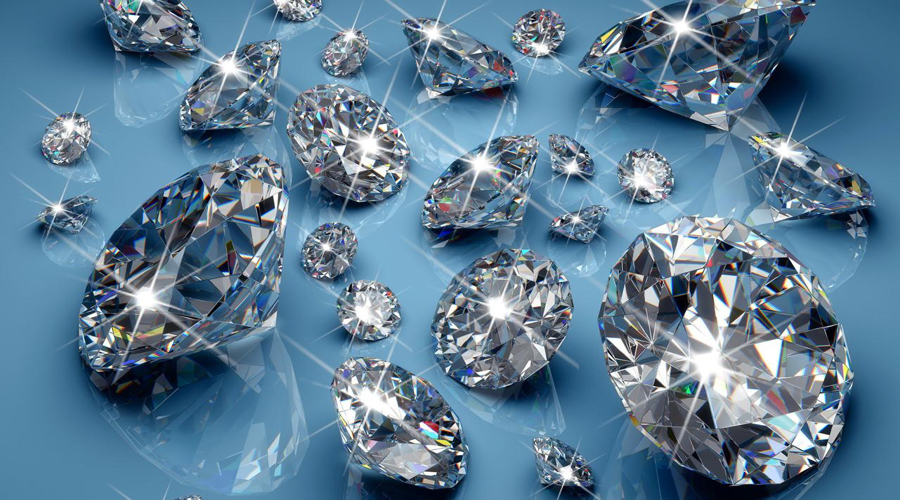4cs

Carat
A carat (ct.) is the unit of measurement specifically used to describe the weight of a diamond (or other gemstones). Its name comes from the carob seed – a small seed with a typically uniform weight that early gem traders used as counterweights for balancing their scales, according to the GIA.
A single carat is equivalent to 0.2 grams, or 200 milligrams, and is divided into 100 points.AA certified diamond that comes with a grading report will indicate the exact carat weight to the nearest hundredth of a carat, in decimal format. A 1-carat diamond has 100 points (1.00) while a ¾ carat stone has 75 points (0.75). Carat weight in pre-set jewelry is typically described as a fraction (e.g. ¾3 carats) and has an equivalent decimal range (¾3 carats = 0.69 – 0.82 points). The following table correlates fractional sizes with their decimal equivalent.
The carat is probably the most familiar of the 4C terms because it is the easiest one to understand just by looking at the stone. However, people often mistakenly assume that a diamond’s size is synonymous with its weight, though that’s not necessarily true. The way a diamond is cut can actually obscure its size and true weight.
It’s important to note that it’s not just the carat weight, but also the quality of the stone at that weight that helps determine the diamond’s value. Factors that determine quality include the cut, color, clarity, and finish. One exceptionally high-quality diamond can sell for $20,000 per carat while a lower-quality one sells for just $1000 per carat.Diamond values also increase disproportionately to the size of the stone, since larger diamonds are more rare. In other words, a three-carat stone with equal color, clarity, and cut can end up costing significantly more than three times the cost of a one-carat stone.

Color
If this is your first time researching diamonds, you may be surprised to learn that these sought-after, natural gemstones come in many different colors and hues.
“Colorless” or “white” diamonds – the diamonds traditionally used for engagement rings, stud earrings and solitaire pendants – are evaluated on a color-grading scale developed by the GIA. It spans the alphabet from D to Z with D being colorless, and Z representing a light yellow tint. With colorless diamonds, the value is placed on how little color you can see, and this is determined by studying the diamond under controlled lighting and comparing it to the GIA’s color scale. Incidentally, D-grade diamonds – that is, truly colorless diamonds – are extremely rare and valuable.
GIA Color Range
Diamonds with a color grade of D, E or F are considered colorless.
Diamonds graded G, H, I and J are near colorless.
Diamonds that fall in the K-M color grade range have a faint yellow tint. Diamonds in the N-R range have a very light yellow tint and S-Z are light yellow.
All loose diamonds available on Diamond.com fall into the D – J (colorless to near colorless) range.

Cut
When you see a diamond in its natural condition it is not very attractive. It is, in fact, very ugly. There is no shine or sparkle to a natural diamond. It could be mistaken for a piece of glass if you did not know what to look for. To create the beautiful diamond that everyone recognizes the stone must be cut and polished
Saws are used to cut diamonds into a round shape. It is from this point that the other shapes of diamonds will be cut. The quality of the cut is more important than the shape of the cut. When a diamond is not cut properly it will lose its ability to catch the light. You will not get any sparkle from a diamond that has been improperly cut. The facets of the diamond must be painstakingly cut with perfect precision to achieve the sparkle that is desired. Once the facets are cut the diamond can be cut into the shape that is desired.
Once the diamond is cut it is put into a cup that is called a dop. In the cup is another diamond because a diamond can only be smoothed by another diamond. When the diamond has been cut shaped and been smoothed by the dop it will be polished on a polishing wheel.
The Selection Of The Cut
There is a wide variety of diamond cuts. The shape of the diamond is what is referred to by cut. The shape of the diamond can be very important in the way the diamond catches and reflects light allowing it to sparkle.
Popular cuts of diamonds are marquise, heart, pear, oval, princess, trillion, and round. Diamond cuts have evolved slowly from the days of the Point Cut to the Old European Cut. The figure shows the stages of evolution.Not only does the cut of the diamond affect the sparkle, but also how well the diamond is cut will affect the sparkle. When a diamond is cut badly it will lose the ability to catch light and not sparkly properly.
If you are in the diamond business then you know that the word cut does not actually refer to the shape of the stone, but the depth, brilliance, clarity, width and durability. There are many variables to determine the cut of the stone. There can be many problems associated with cutting the diamond that will make the diamond less desirable. If the tool is damaged or there is a misalignment of the cut the diamond will be affected.
When you are shopping for a diamond you should select the shape that you want. But you should also take a look at a few shapes of diamonds to find one that has the best cut. This will be the diamond that has the best sparkle in any light.

Clarity
The clarity of a diamond is one of the biggest factors used to determine its value. It is very important to understand how to give a grade to the clarity of a stone that you are looking at. It is also very easy to learn to determine the clarity of your stone.
There are two things that must be understood when it comes to clarity. The first thing is that the stone must appear blemish free to the naked eye. This is called eye clean. After that the clarity can be determined through different categories.
A great many people believe that clarity means the clearness of the diamond. This is not what clarity means at all. Clarity specifically means the flaws that are on the surface of the stone and on the inside. The diamonds that receive the highest rating are called FL or flawless. IF will mean internally flawless. A grade of I-1, I-2 and I-3 refers to the flaws internally on the stone. I-3 is the worst rating the stone can receive.
There are also other grades that a stone can receive such as VVS1 or VVS2, which refers to a stone that is very very slightly flawed. A rating of VS1 and 2 refers to a stone that is very slightly flawed and S1 and 2, which means slightly flawed.